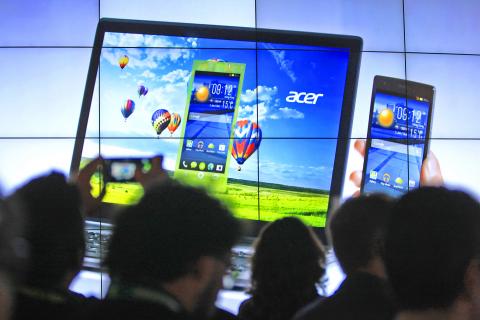Sony Corp on Wednesday unveiled new mobile devices which can function as displays for PlayStation games, as it adds features to win sales in a market dominated by Apple Inc and Samsung Electronics Co.
The marquee Xperia Z3 smartphone is waterproof and comes with a battery that can stay charged for two days, Sony said on its Web site. The Tokyo-based company also announced the Z3 Compact smartphone with a 4.6-inch screen and an 8-inch tablet computer.
Chief executive officer Kazuo Hirai has been pushing his “One Sony” plan aimed at better integrating the company’s electronics and entertainment assets to revive earnings.

Photo: Bloomberg
The PlayStation 4 has been one of the few bright spots for Sony, outselling Microsoft Corp’s Xbox One, amid a decade of television losses and lackluster demand for Xperia smartphones, which barely crack the top 10 globally in shipments.
Sony is forecasting its sixth annual loss in seven years and Hirai cut the company’s full-year smartphone sales projection to 43 million units from an earlier forecast of 50 million.
Meanwhile, Taiwan’s Acer Inc (宏碁) and Asustek Computer Inc (華碩), as well as South Korea’s Samsung Electronics Co and other electronics companies, on Wednesday unveiled their latest product lineups ahead of the Sept. 5 through Sept. 10 IFA electronics trade show in Berlin, Germany, with an eye on the year-end holiday shopping season in the US.
Acer showcased three Iconia series tablets running on Windows and Android operating systems, and a new Liquid series smartphone, claiming it is the smallest and lightest 5-inch device on the market. It announced plans to release a 50 euro (US$66) smartphone next year.
However, the Taiwanese company insisted that the keyboard computer market was not dead and introduced two Aspire R series convertible notebooks and two Aspire Switch series two-in-one PCs.
The company is optimistic about its turnaround progress and expects its third-quarter revenues to maintain growth momentum, based on its back-to-school promotions and the worldwide release of new products scheduled for the second half of the year.
As for fellow Taiwanese manufacturer Asustek, the company took the wraps off the ZenWatch, its first smartwatch using the Android Wear operating platform. The wearable can be paired with newer Android phones to display information and monitor the wearer’s activity. The watch can be used to find a smartphone, something Samsung has done with some of its watches, as long as the phone is also made by Samsung.
ZenWatch comes at a higher-than-expected starting price of US$262, more expensive than LG Electronic Co’s G Watch priced at US$179 and Sony’s SmartWatch 2 at US$199, but cheaper than the Samsung Gear 2 which starts at US$299.
Other new products Asustek showcased included the 13.3-inch Zenbook UX305 laptop, the 11.6-inch EeeBook X205 laptop running the Windows 8.1 operating system, and the 7-inch MeMO Pad 7 Android tablet powered by an Intel Atom 64-bit quad-core processor.

TAKING STOCK: A Taiwanese cookware firm in Vietnam urged customers to assess inventory or place orders early so shipments can reach the US while tariffs are paused Taiwanese businesses in Vietnam are exploring alternatives after the White House imposed a 46 percent import duty on Vietnamese goods, following US President Donald Trump’s announcement of “reciprocal” tariffs on the US’ trading partners. Lo Shih-liang (羅世良), chairman of Brico Industry Co (裕茂工業), a Taiwanese company that manufactures cast iron cookware and stove components in Vietnam, said that more than 40 percent of his business was tied to the US market, describing the constant US policy shifts as an emotional roller coaster. “I work during the day and stay up all night watching the news. I’ve been following US news until 3am

UNCERTAINTY: Innolux activated a stringent supply chain management mechanism, as it did during the COVID-19 pandemic, to ensure optimal inventory levels for customers Flat-panel display makers AUO Corp (友達) and Innolux Corp (群創) yesterday said that about 12 to 20 percent of their display business is at risk of potential US tariffs and that they would relocate production or shipment destinations to mitigate the levies’ effects. US tariffs would have a direct impact of US$200 million on AUO’s revenue, company chairman Paul Peng (彭雙浪) told reporters on the sidelines of the Touch Taiwan trade show in Taipei yesterday. That would make up about 12 percent of the company’s overall revenue. To cope with the tariff uncertainty, AUO plans to allocate its production to manufacturing facilities in

Six years ago, LVMH’s billionaire CEO Bernard Arnault and US President Donald Trump cut the blue ribbon on a factory in rural Texas that would make designer handbags for Louis Vuitton, one of the world’s best-known luxury brands. However, since the high-profile opening, the factory has faced a host of problems limiting production, 11 former Louis Vuitton employees said. The site has consistently ranked among the worst-performing for Louis Vuitton globally, “significantly” underperforming other facilities, said three former Louis Vuitton workers and a senior industry source, who cited internal rankings shared with staff. The plant’s problems — which have not

COLLABORATION: Given Taiwan’s key position in global supply chains, the US firm is discussing strategies with local partners and clients to deal with global uncertainties Advanced Micro Devices Inc (AMD) yesterday said it is meeting with local ecosystem partners, including Taiwan Semiconductor Manufacturing Co (TSMC, 台積電), to discuss strategies, including long-term manufacturing, to navigate uncertainties such as US tariffs, as Taiwan occupies an important position in global supply chains. AMD chief executive officer Lisa Su (蘇姿丰) told reporters that Taiwan is an important part of the chip designer’s ecosystem and she is discussing with partners and customers in Taiwan to forge strong collaborations on different areas during this critical period. AMD has just become the first artificial-intelligence (AI) server chip customer of TSMC to utilize its advanced